HEU-UDE Workshop on Ship and Marine Mechanics
Introduction to the Workshop
This workshop is co-organized by the College of Shipbuilding of Harbin Engineering University and the Institute for Ship Technology and Ocean Engineering of University of Duisburg-Essen, Germany, aiming at creating a new platform for young scholars to jointly explore the key issues in fluid mechanics and fluid-structure interaction, and promoting international academic exchanges.
Date, Time, and Venue
August 15, 2023; 9:00-17:30; Chuanhai Building, Room 1013
Contact
College of Shipbuilding Engineering
Pu Cui (Mobile Phone) 18846459106
Program
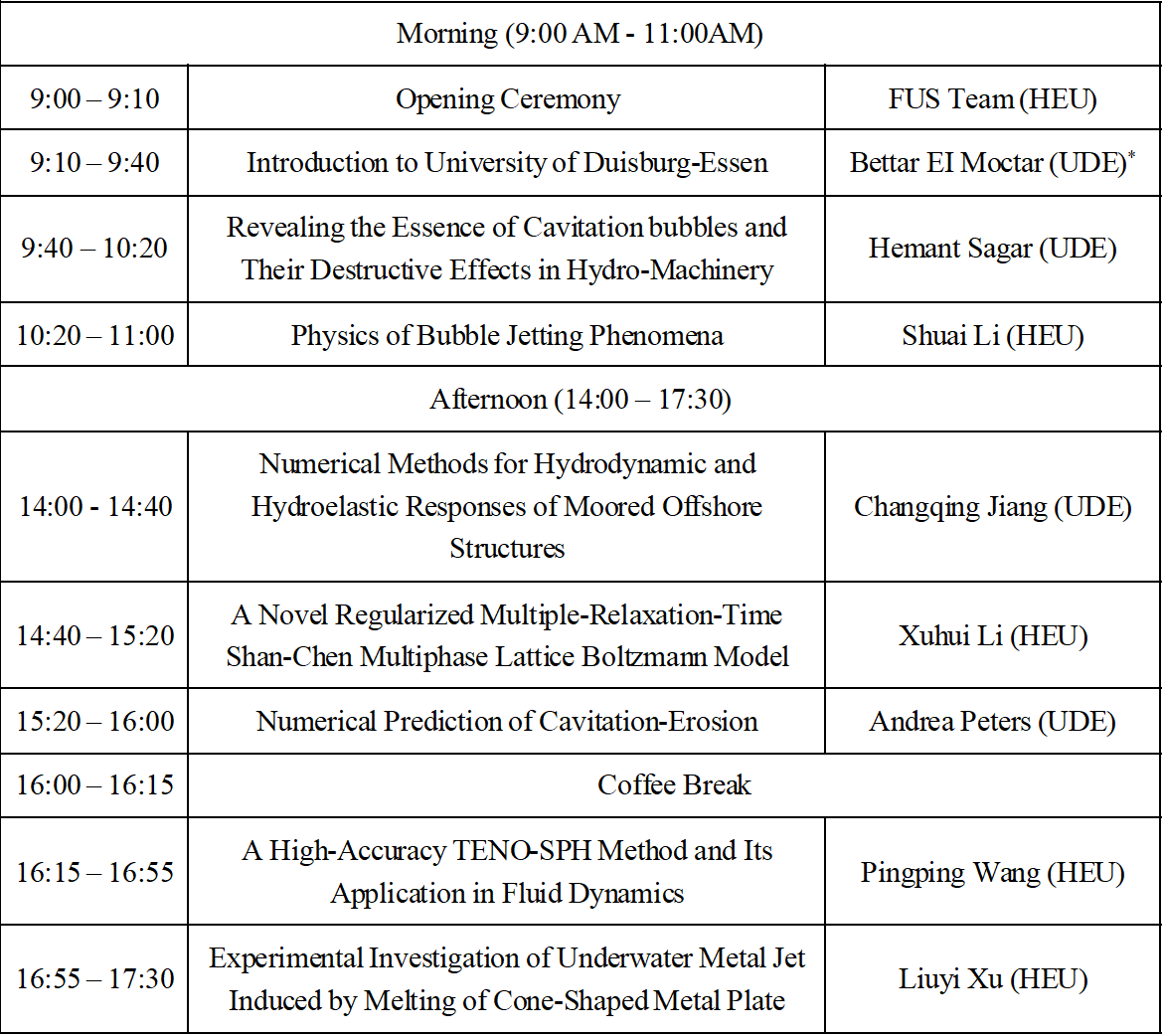
*The Presentation of Bettar Ould El Moctar and Andrea Peters will be performed by Hemant Sagar due to their itinerary changes.
Presentations
1. Introduction to University of Duisburg-Essen
Abstract: This presentation will introduce the University of Duisburg-Essen (UDE) - one of the youngest and largest universities in Germany. The university is located in the middle of the Ruhr Metropolitan Region. Its broad spectrum of subjects ranges from humanities, social sciences and education to economics, engineering, natural sciences and medicine. Since its foundation in 2003, the UDE has developed into a globally recognized research university.

2. Revealing the Essence of Cavitation bubbles and Their Destructive Effects in Hydro-Machinery
Abstract: The presentation will cover the basics of the well-known problem occurring in hydro machinery “cavitation”. The aim of the presentation will be to deliver the in-depth insight into the fundamentals of the cavitation, its severity in the direction of its destructive mechanism. For this purpose, the first part of the presentation will cover the numerical and experimental studies of the dynamics of a cavitating bubble near a resilient metal surface. The second part of the presentation will cover the advanced approach correlating to the hydro machinery such as pumps, impeller and turbine. To achieve this, experiments and simulations were performed for bubble collapsing between non-parallel plates at various positions. The initial position of the bubble and, thus, the boundary conditions significantly influenced the bubble’s dynamics.

3. Physics of bubble jetting phenomena
Abstract: The application of bubbles is extensive, and relevant fundamental research holds significant engineering value and academic significance. The nonlinear dynamic behavior of bubbles, particularly high-speed jetting, is highly dependent on the boundary conditions and the physical characteristics of the flow field. This report aims to present the latest research findings concerning the physical characteristics of bubble jets, encompassing aspects such as gravitational effects, proximity to solid boundaries, interactions with movable boundaries, as well as variations in bubble jet characteristics near liquid-liquid fluid interfaces.
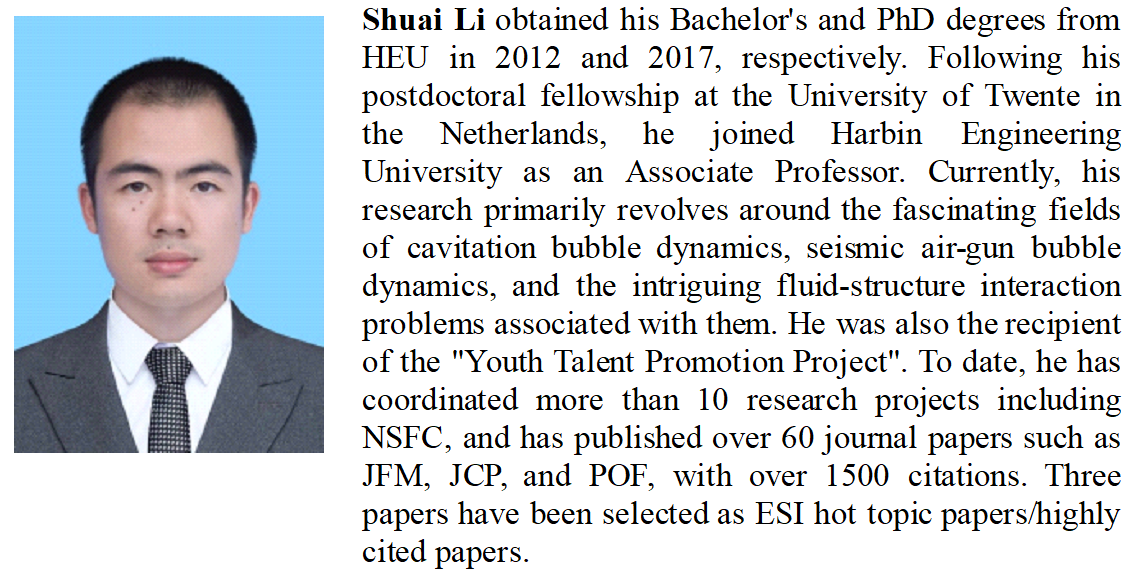
4. Numerical Methods for Hydrodynamic and Hydroelastic Responses of Moored Offshore Structures
Abstract: Predicting wave-induced motions and loads on ships and offshore structure is often part of their designs, and numerical methods play a crucial role in such a content. This presentation covers the state-of-the-art numerical tools including potential-flow and viscous-flow solvers coupled with mooring dynamics, mechanical connections, and structural dynamics. Aiming to account for the nonlinear fluid-structure interaction, mooring dynamics, and associated viscous flow effects, a coupled mooring-viscous flow solver is developed by solving the equations governing mooring dynamics, six-degree-of-freedom nonlinear body motions, and fluid dynamics in a coupled manner. The fluid-structure interaction is considered using both a conventional Finite-Volume-Finite-Element (FV-FE) approach and a novel self-contained FV-FV method. Validations and applications using the developed solver are demonstrated.
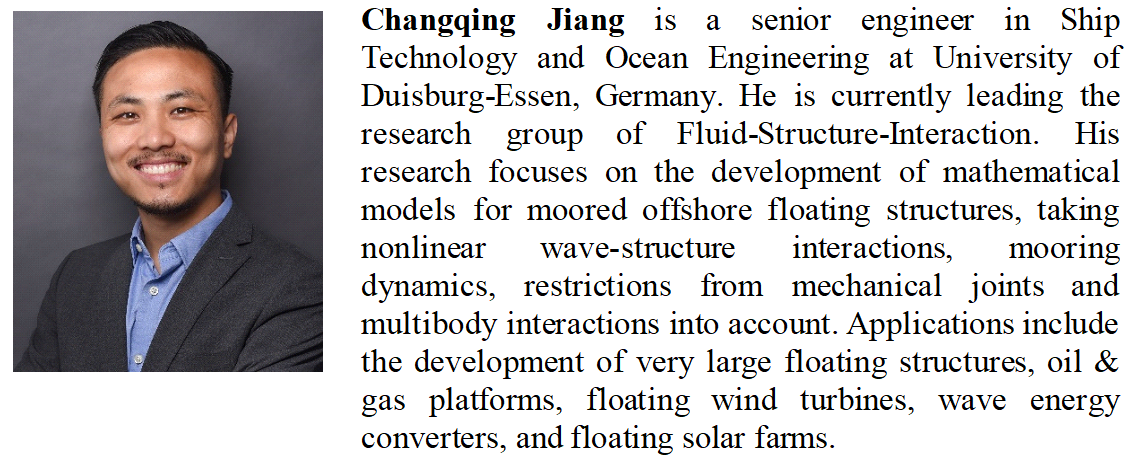
5. A novel regularized multiple-relaxation-time Shan-Chen multiphase lattice Boltzmann model
Abstract: The Shan-Chen lattice Boltzmann model has been widely applied for the multiphase/multicomponent flows, such as phase separation, cavitation and boiling. However, there exist several drawbacks that hinder its success in the accurate and stable simulations in these physical scenarios, such as numerical stability for high density ratio and high Reynolds number, independent adjustment of surface tension in contrast with the density ratio. In this work, a regularized multiple-relaxation-time Shan-Chen multiphase lattice Boltzmann model has been proposed. Due to the multiple-relaxation-time regularization procedure, the robustness has been guaranteed for the high density ratio and low viscosity case. By incorporating a source term, the surface tension can be successfully adjusted independently in contrast with the density ratio.
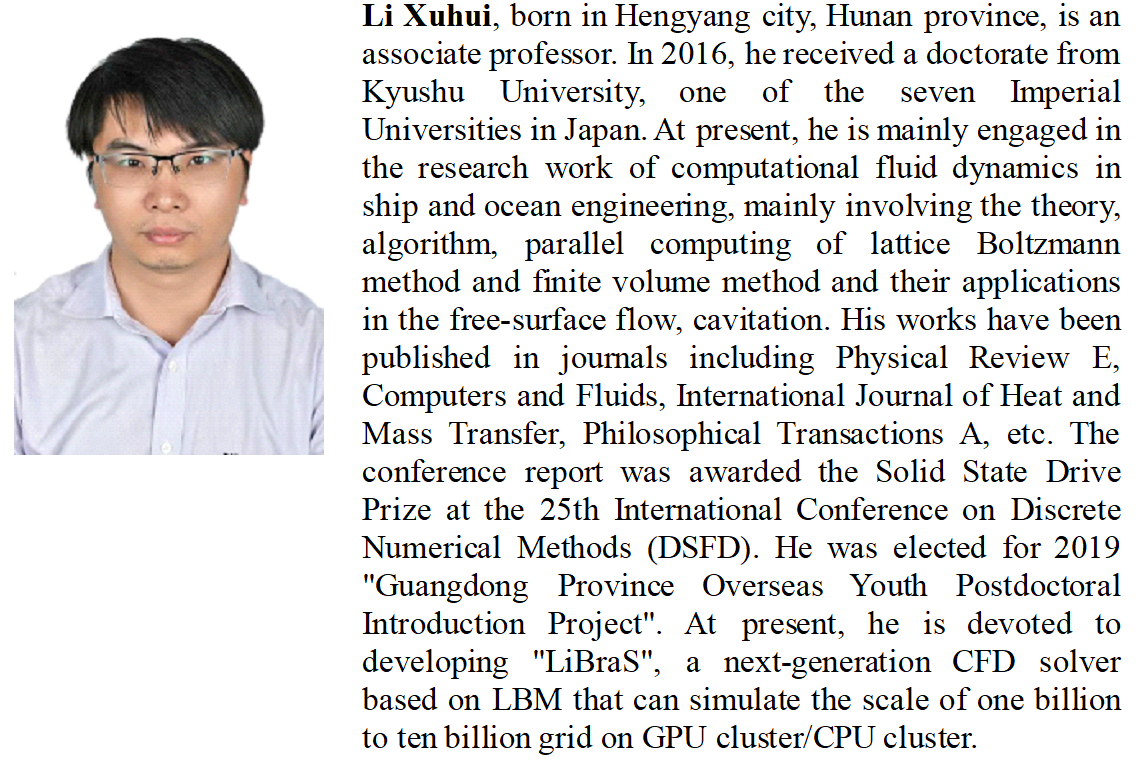
6. Numerical prediction of cavitation-erosion
Abstract: This presentation will cover the developed numerical method to predict the cavitation induced erosion. The erosion model is based on the microjet phenomenon and its development. An Euler-Lagrange method to simulate cavitation and predict cavitation erosion is presented. The method considers bubble motions as well as growth and collapse of a discrete number of single, spherical bubbles. A two-way coupling approach is implemented so that both liquid phase and vapour bubbles interact with each other. In contrast to Euler-Euler methods, this allows a more detailed simulation of bubble transport and dynamics.
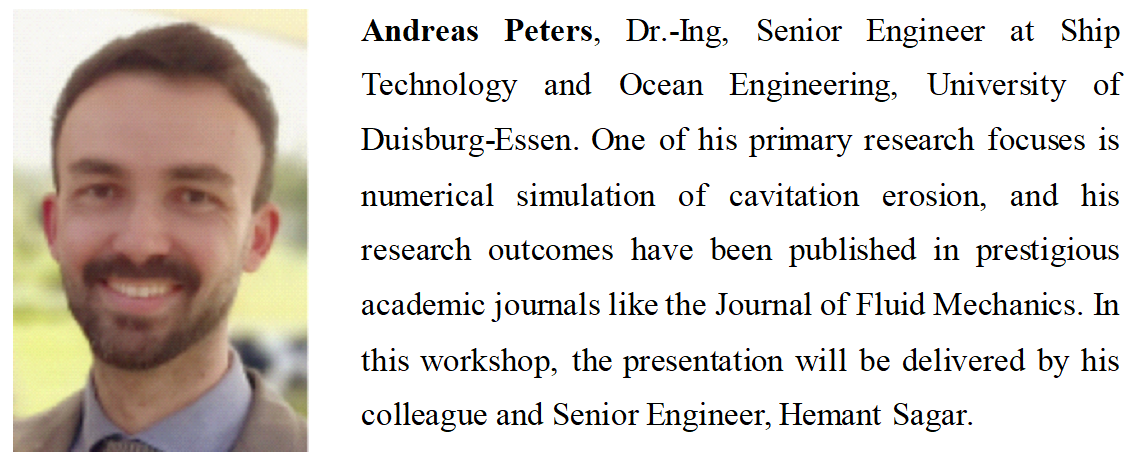
7. A High-Accuracy TENO-SPH Method and Its Application in Fluid Dynamics
Abstract: In order to improve the accuracy of SPH, based on the Riemann SPH method, the TENO reconstruction algorithm from the grid methods is introduced. Since TENO reconstruction often requires equally spaced points to construct templates, and the particles in SPH are randomly distributed, we proposed a new template point reconstruction method under the SPH framework and use a modified kernel gradient approximation algorithm. Numerical results showed that the proposed TENO-SPH has higher accuracy than the traditional Riemannian SPH method, and is effective in simulating compressible flows, incompressible eddies, and free surface flows involving shock waves and small-scale structures.
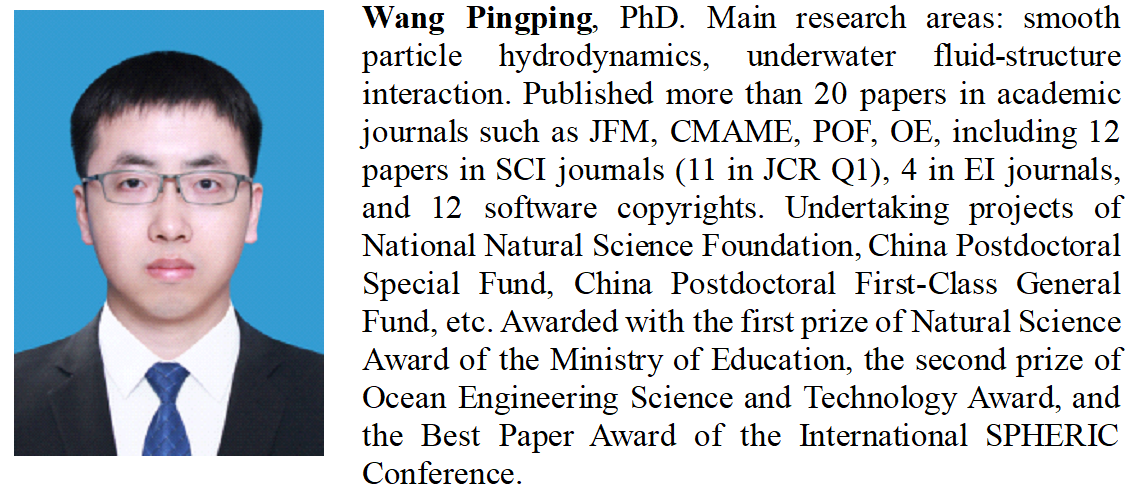
8. Experimental investigation of underwater metal jet induced by melting of cone-shaped metal plate
Abstract: We performed a series of experiments on melting and deforming of metal plates underwater with the special scientific test base in Jiangxi province. The experiments were conducted in a cistern with a reinforced concrete structure, equipped with pressure and strain sensors. The complex fluid-solid interaction phenomena were recorded by a high-speed camera. Two different structures were employed in the experimental studies, including the unstiffened and stiffened plates. Moreover, a laser three-dimensional scanner was used to measure the deformation of the plates. Through analyzing the experiment data, we can study the near-field characteristics of underwater metal jet and the mechanism of deformation of the plate structure.
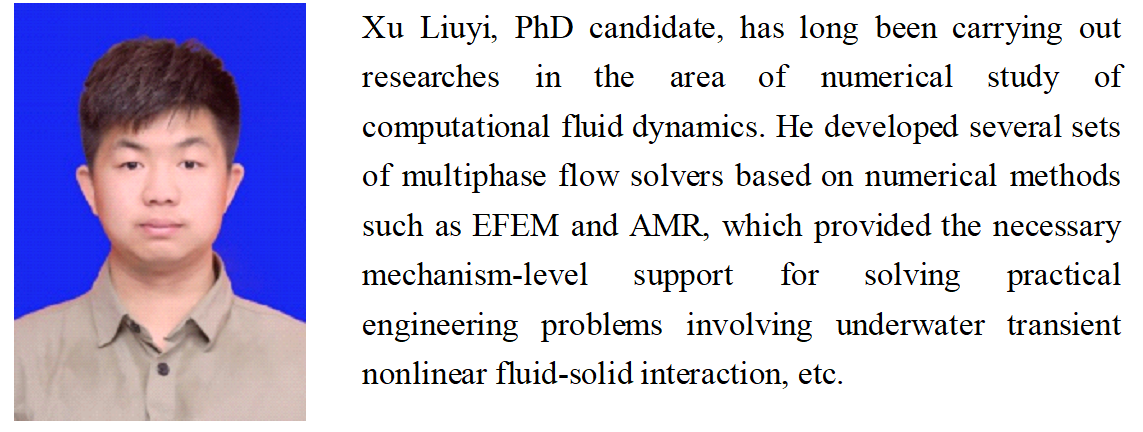
---------------SPONSORS---------------
Institute of Mechanics, College of Shipbuilding Engineering, Harbin Engineering University
MOE International Joint Laboratory of Naval Architecture and Offshore Technology
The National International Joint Research Center for Naval Architecture and Marine Engineering Mechanics of the Ministry of Science and Technology
Association of Young Scientists and Researchers, College of Shipbuilding Engineering, Harbin Engineering University